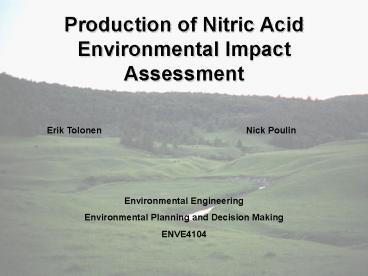Production of Nitric Acid - PowerPoint PPT Presentation
1 / 18
Title:
Production of Nitric Acid
Description:
Nitric Acid (HNO3) Nitric Oxide (NO) Nitrogen Dioxide (NO2) Nitrous Oxide (N2O) ... Oxide. n/a. 0.037 mg/m3 (NAAQS) Nitrogen Dioxide. n/a. n/a. Nitric Oxide. n ... – PowerPoint PPT presentation
Number of Views:1955
Avg rating:3.0/5.0
Title: Production of Nitric Acid
1
Production of Nitric Acid Environmental Impact
Assessment
Erik Tolonen
Nick Poulin
Environmental Engineering Environmental Planning
and Decision Making ENVE4104
2
Contents
Introduction Risk Assessment Fault Tree Event Tree
3
Introduction
- Chemicals of Interest
- Ammonia (NH3)
- Nitric Acid (HNO3)
- Nitric Oxide (NO)
- Nitrogen Dioxide (NO2)
- Nitrous Oxide (N2O)
Ammonia was determined to be the most hazardous
chemical present in the process
4
Hazard Identification
All chemicals are non-carcinogenic
5
Hazard IdentificationNH3
Ammonia is considered to be toxic by the Canadian
Environmental Protection Act
- Human Health Effects
- Causes irritation of the eyes, skin and
respiratory system - No Observed Adverse Effect Level (NOAEL) 6.4
mg/m3 - Lowest Observed Adverse Effect Level (LOAEL)
17.4 mg/m3 - Respiratory lesions increase the severity of
pneumonia and rhinitis - Environmental Effects
- Impact on certain types of plants and trees
(reduced ability to retain water)
6
Exposure Assessment
7
Transport Media
Transport Mechanism
Exposure Mechanism
Population at Risk
8
Air Transport Model
Assumptions - Transport by advection and
dispersion only - Ammonia is released from a 20 m
height stack with a 10 m plumb rise - Wind
direction is directly towards the city (Worst
Case Scenario) - No density or buoyancy effects
Gaussian Model Parameters - Atmosphere Stability
Class D - Rate of Emission 0.062 kg/s (223.2
kg/hr) over 30 hours - Total Amount of Ammonia
Released 6696 kg - Inhalation Reference Exposure
Level 0.3 ppm
9
(No Transcript)
10
City
11
Air Transport Model
Results - Ammonia levels in the city will reach
0.3 ppm when emission rate reaches 80311.7 kg/s
(80.3 tonnes/s). - Amount required is much
greater then current release at plant
12
Water/Ground Water Transport Model
Assumptions -Transport by advection
only -Thoroughly mixed with river water -No
retardation or attenuation present in soil
Advection -Flow time to reach city 84.3
yrs -Flow time to reach river 28.2 yrs
- Solubility
- 42.8 wt at 0 OC
- - Amount of Ammonia entering groundwater
insignificant
13
Exposure Assessment
- Intake Dose
- I CxCRxEFxED/BWxAT
- C Conc. at exposure point 0.00008 ppm
(0.00011mg/m3) - CR Contact Rate 289.5 m3/hr 6947 m3/day
- EF Exposure Frequency 1.25 days/year
- ED Exposure Duration 30 hrs 0.003 year
- BW Body Weight 70 kg
- AT 1.25 days
- I 0.00003 mg/kg-day
14
Toxicity Assessment
- Case Studies
- (1) Soda Ash Facility Workers Exposed to Ammonia
- No Observed Adverse Effect Level (NOAEL) 9.2
ppm (6.4 mg/m3) - (2) 344 Rats Exposed to Ammonia
- Lowest Observed Adverse Effect Level (LOAEL)
17.4 mg/m3
15
Risk Characterization
- Hazard Index for Ammonia
- HI CDI/RfC
- CDI chronic daily intake
- RfC reference dose 0.3 ppm
16
Fault Tree
17
Event Tree
18
Conclusions
- Conclusions































